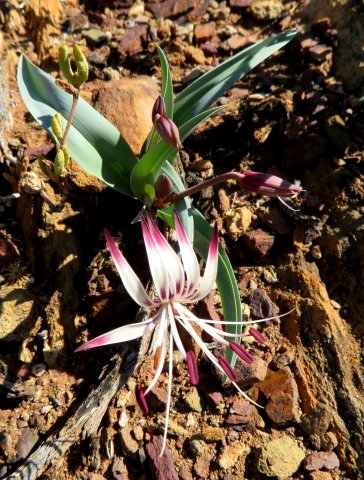Ornithoglossum

Author: Ivan Lätti
Photographer: Thabo Maphisa
Ornithoglossum is a genus of hairless, perennial geophytes in the Colchicaceae family. Their deep-seated corms are ovoid, somewhat globose or tuberous, sometimes with one or two blunt lobes. The corm tunics are thin and yellow or dark and papery, sheathing the neck below-ground. The stem is erect, variable in length and sometimes branched.
The lowest leaf is usually a sheathing, membranous and tubular cataphyll lacking a blade and often not seen. The two to twelve upper leaves are alternate, stem-clasping and distichous, i.e. growing in two opposite, vertical arrays. The leaves are lanceolate and channelled, tapering to acutely pointed tips, sometimes with small, apical protrusions as well. The smooth blades are green, grey-green or blue-green. Some species have wavy leaf margins.
The inflorescence growing after the flowers is an oblong, pyramidal or corymb-like raceme at the stem-tip. It has leaf-like bracts below the long pedicels of the flowers. The flowers nod, while the tepals bend in the opposite direction to the pedicel.
The perianths comprise six free tepals clawed at the base where each has a hollow nectary. The tepal colours range from green, yellow and white to maroon, purple, brown and black.
There are six stamens comprising thread-like filaments, sometimes swollen low down and topped by oblong anthers. The superior ovary is globose, ovoid or oblong in shape and has three locules. The three thread-like styles serving the locules are free from the base, tipped with tiny stigmas, hardly discernible.
The fruit capsule is leathery, dehiscing longitudinally per chamber or locule. The globose seeds are brown, sometimes with smooth surfaces but a distinct seam.
There are nine Ornithoglossum species, all in tropical and southern Africa. Several species are cultivated as garden ornamentals. The plants are poisonous to stock, causing losses among animals unaccustomed to them. The toxicity is reflected in the snake lily common name, although the slangkop (snake head) is more commonly associated with Drimia species of another family, the Hyacinthaceae.
The plant in picture is Ornithoglossum undulatum (Leistner, (Ed.), 2000; Vlok and Schutte-Vlok, 2015; Manning, 2007; Vahrmeijer, 1981).

